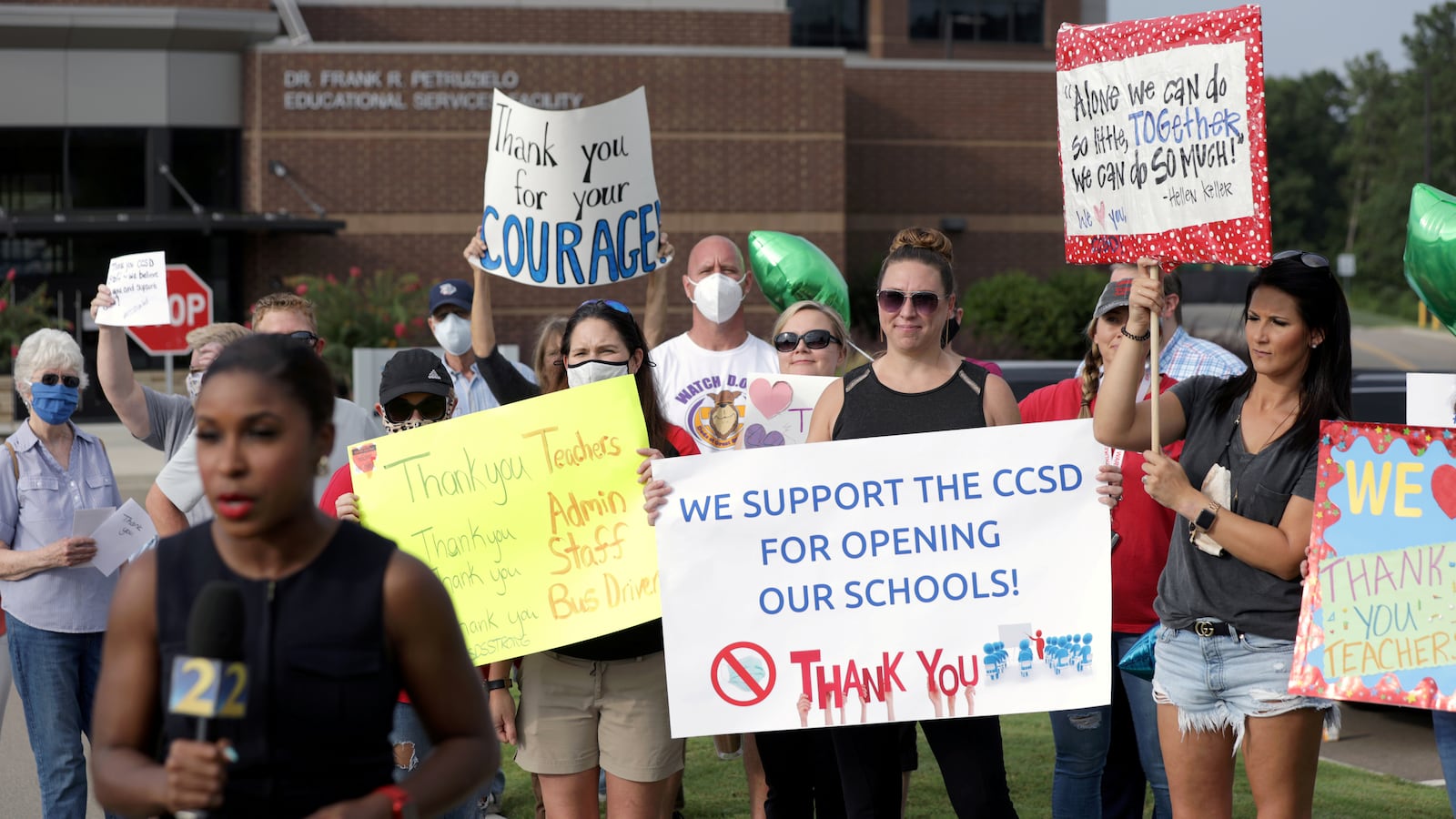The email from the principal had a lighthearted, friendly tone, but the news she delivered was alarming: Three more students at Creekview High School in Canton, Georgia, had tested positive for the coronavirus—the fourth such letter sent to parents that week.
That out of the way, she then moved on to what she called a “distraction,” noting that the high school volleyball team would be playing in a tournament the next day. “Come to CVHS to see our lady Grizzlies play at 9:00 10:00 or 12:30,” she wrote. “Go Grizzlies!”
Two days later, after 25 students tested positive and more than a quarter of the student body was placed in quarantine, the entire school was shut down.
In the three weeks since school started in Cherokee County, Georgia, three of the district’s six high schools have temporarily shuttered due to coronavirus outbreaks. As of Friday, 2,000 of the 42,000 students in the district were in quarantine.
But the county—once a heart of the Cherokee Nation, now a bastion of support for Donald Trump—has shown no sign of suspending in-person education or beefing up its policy of encouraging but not requiring face masks.
Many parents and teachers in the district—where one school wanted students to disinfect classrooms—say they are terrified of what will happen if the status quo is allowed to continue.
“I kind of feel like Cherokee County has been the guinea pig for the state, or the nation,” said Meg Du Plooy, a mother of two Cherokee County students. “Just an experiment to see what happens if we open all the schools and have everyone come back in.”
At a school board meeting Thursday, Superintendent Brian Hightower suggested for the first time that the now-shuttered high schools may move to a “hybrid model” in which students attend school in-person only a few days a week.
“Right now we’ve got a few high schools where it’s so hot—or there’s such a cluster that seems to be following one school—that we’re not sure when we can get them open,” he said.
“We want something better than coming, reporting, popping in, popping out,” he added. “We want to look at some alternatives, and we think these could be three great lab situations for us to utilize that.”
Parents first started to worry this spring, when the district allowed graduation to take place in-person, inside a church auditorium. (Photos that were circulated among parents and obtained by The Daily Beast show school board member Kelly Poole standing with the graduates onstage, her mask folded in her hands.)
But the real trouble started when the school announced its reopening plan. In an 85-page document—sent to teachers and parents one day before it was to be voted on—the district said it would not be pushing back the start of the school year or requiring masks in its classrooms.
Despite the short notice, 6,000 people watched the school board meeting online, and a contentious question-and-answer session followed. Directly after, the board voted unanimously to approve the plan.
Things only got worse from there. Though families were given the option to continue learning remotely, approximately 75 percent opted for in-person learning, meaning hallways and common areas were crowded and class sizes could not be meaningfully reduced. A viral photo taken the first day of classes at Sequoyah High School showed dozens of students crammed together for a photo, none of them in masks. The photo was shared on—and later removed from—the school’s official Instagram account.
Teachers who spoke to The Daily Beast said the few promises the district did make have not been fully kept. Bell schedules at some schools have not been staggered as planned, meaning teachers are given five minutes to disinfect their classrooms before the next class arrives.
Despite assurances that additional cleaning would take place overnight, one teacher said she returned to her classroom after a “deep clean” to find the desktops had not been washed. One school even offered volunteer hours to students who spent 15 minutes wiping down desks after school, according to emails reviewed by The Daily Beast. (The offer was later retracted.)
Whatever additional cleaning does take place, these teachers said, happens largely after hours, when both they and their students are out of the building.
"For two weeks, pretty much all that got done in our rooms was emptying the trash—or at least that's what we were able to notice,” said one teacher, who asked to remain anonymous for fear of losing her job. “In a pandemic, our classrooms need more than just the trash cans emptied.”
In an email to The Daily Beast, CCSD’s Chief Communications Officer Barbara Jacoby said the district “continuously review[s] protocols to determine additional improvements” and had “implemented changes to initial protocols as a result of feedback,” including the provision of face shields to teachers who wanted additional protection.
Jacoby said teachers were not required to clean their rooms between classes, and that cleaning supplies were provided so that teachers could wipe down frequently used surfaces “if they so choose.” She added that the district had spent an additional $4 million on safety supplies and that a “certified disinfection specialist” was placed on the custodial team at every school to focus on disinfection of high-touch areas. (Teachers interviewed by The Daily Beast said this mainly looked like someone walking around cleaning doorknobs.) The deep-cleaning process, Jacoby said, “includes disinfectant misting and which takes place after school hours.”
A number of teachers did commend their schools for such precautions as halving the number of students in each lunch period, providing extra hand sanitizer and cleaning supplies, and making the hallways one-way. But many of them also said they felt largely unsupported by the district as a whole.
“My administration themselves have been great at trying to keep us safe,” said one teacher, who also requested anonymity for fear of retaliation. “But it seems like the people at the district level, they don’t seem to care if we live or die.”
Some of this feeling stems from communications from the district itself. In one email sent to teachers at the beginning of the school year and reviewed by The Daily Beast, Superintendent Brian Hightower told teachers who were unhappy with facets of the reopening plan to “reflect on the best direction forward for you in your role with [the district]”—a comment some teachers saw as a threat to their employment.
Hightower later apologized for the message in another email, writing that he “should have done a much better job of sharing my appreciation for both your efforts and concerns as it relates to our school reopening.”
In a Q&A document posted online, one parent noted that some teachers’ social media posts made it seem like they were “afraid to return to work,” and worried that they would treat their children differently if they opted for face-to-face learning.
“We apologize, as a school district, if a teacher has argued with you on social media or made you otherwise not have confidence in their ability to effectively teach your child,” the district responded, not addressing the comment about teachers’ fears. “All teachers are expected to follow our social media guidelines for employees, which make clear this should not occur online.”
The message from the district, one teacher said, “has been loud and clear: Shut up and do your job.” Jacoby said teachers were encouraged to share safety concerns with principals or through an anonymous tip line.

Supporters of the Cherokee County School District's decision to reopen schools rallied outside the district's headquarters earlier this month.
Dustin Chambers/ReutersParents who disagree with the district—a group of largely liberal residents in a town that went 73 percent for Trump in 2016—said they feel pressured to stay silent. In the wake of the decision to reopen schools, dozens of parents turned out to a rally to support in-person learning without a mask mandate. One participant arrived with signs promoting the outlandish conspiracy theory that the effects of the virus are being exaggerated to make Trump look bad. “Thank you CCSD! #endtheelectioninfection,” one sign read.“Did you know that the coronavirus has a patent? Why is the government lying to us?” read a second, referring to another roundly debunked conspiracy theory.
A more than 6,000-member “CCSD Positivity Vibes” group has formed on Facebook, the stated purpose of which is to support students and staff but which some parents say is being used to stifle dissent. (Several school board members belong to the group and post occasionally.)
Lea Dearing, an adminisrator of the Facebook group, didn’t anticipate it would take off like it has. “It was not created for the purpose of pledging support to the reopening plan,” she told The Daily Beast. “It was created after the reopening plan was announced when we realized that our teachers and school staff and bus drivers were under extreme stress and needed extra support. No matter their personal views (and those vary widely) they were going to be back in the schools.”
When the district announced that Creekview would be shutting down, one member encouraged others to comment on the Facebook post and “flood the comment section with love.” The announcement now has more than 750 comments, several of them comparing the fatality rates of the coronavirus to the flu and spreading misinformation about masks.
“That can be a lot to handle when you’re progressive in this area,” said Miranda Wicker, a former Cherokee County school teacher who has been vocal about her concerns with the reopening plan. “It’s very hard to speak out in that environment and be heard, because there's just mass amounts of people so quick to shut you down.”
Both teachers and parents said they felt the conservative bent of the town had influenced the school board’s decision to reopen without a mask mandate. The board is entirely Republican, and almost half of them—including the board chair—are up for re-election again this year.
But at least one teacher was equally worried about how the parents’ views influenced their children.
“The kids feel like they’re invincible,” she said. “Just hearing them talk and it’s like, everybody’s going to get it anyway and life goes on.”
She added, “It doesn’t hit home until the reality is right in front of their face.”



